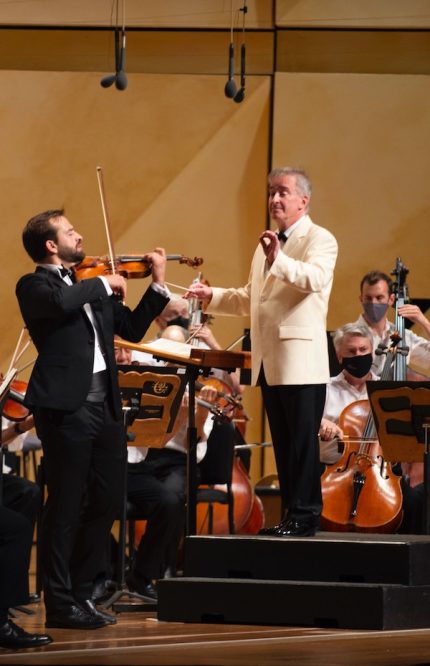Conlon returns to Ravinia with a mixed evening of Mozart

Former Ravinia Festival music director James Conlon returned on Friday night to conduct an all-Mozart program with the Chicago Symphony Orchestra. In his opening remarks, Conlon said that the concert was about healing and that Mozart heals more than anyone. This characterization might suggest a sunny, soothing approach to this music, but Conlon emphasized drama instead.
This was clear from the bracing chords of the program’s opener, the Overture to La clemenza di Tito. Conlon eschewed lightness for heft—fitting given the opera’s weighty political subject matter. The only flaw in this interpretation was an unwillingness to get quiet enough in the softest passages, such as in the beginning of the grand buildup in the exposition’s transition.
Violinist William Hagen was the evening’s soloist. Hagen delivered two-thirds of a worthy performance of Mozart’s Violin Concerto No. 5 (nicknamed “Turkish” due to the Janissary band imitations in the finale).
Hagen’s first entrance was captivating, floating delicately above the orchestra. His tone in both of the first two movements was airy, his vibrato subtle enough to add warmth without excessive sentiment. In the slow movement in particular, his phrasing felt songful and natural.
It is a pity, then, that Hagen abandoned this naturalness in the finale. His rendition of the main theme was a catalogue of affectations, as he seized on every chance to suddenly alter the dynamics, articulation, or tempo, whether this made sense or not. His antics appeared to throw off Conlon and the orchestra, and coordination suffered as a result.
The last item on the program was the Symphony No. 41 (“Jupiter”). Here Conlon elicited a huge dynamic range from the orchestra. The grand flourishes that begin the symphony were responded to by a hushed choir of strings. In the minuet, the somewhat playful opening gambit was met with a commanding tutti.
Conlon’s strikingly flexible tempi within movements came as a surprise, the performance mkaing the music feel more like a Romantic-era work than Classical. There were some awkward gearshifts, and it felt like additional rehearsal time may have been more effective in pulling off this approach.
The CSO strings played the symphony’s legato passages with an almost Karajan-esque luxuriance. Only in the development of the first movement was this extreme smoothness a liability. It was most effective in the slow movement, which was the symphony’s highlight, due to Conlon’s intelligent shaping of its form.
The finale is the acme of Classical-period counterpoint. The Ravinia pavilion acoustic likely contributed to mitigating most of these intricacies, so Conlon emphasized the energetic sweep of the movement’s passagework and fanfares.
Throughout the concert, all of the CSO’s first-desk winds supplied characterful solo work, particularly principal flutist Stefán Ragnar Höskuldsson, whose nimble staccato playing in the Overture and the symphony finale was essential in balancing out the evenness of the strings.
Violinist Stella Chen and violist Matthew Lipman join conductor Yue Bao and the CSO for a concert of Chen Yi, Mozart, and Tchaikovsky 5 p.m. Sunday. ravinia.org
Posted in Performances




